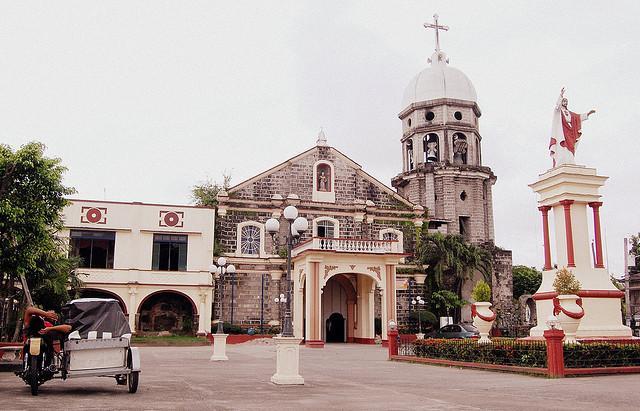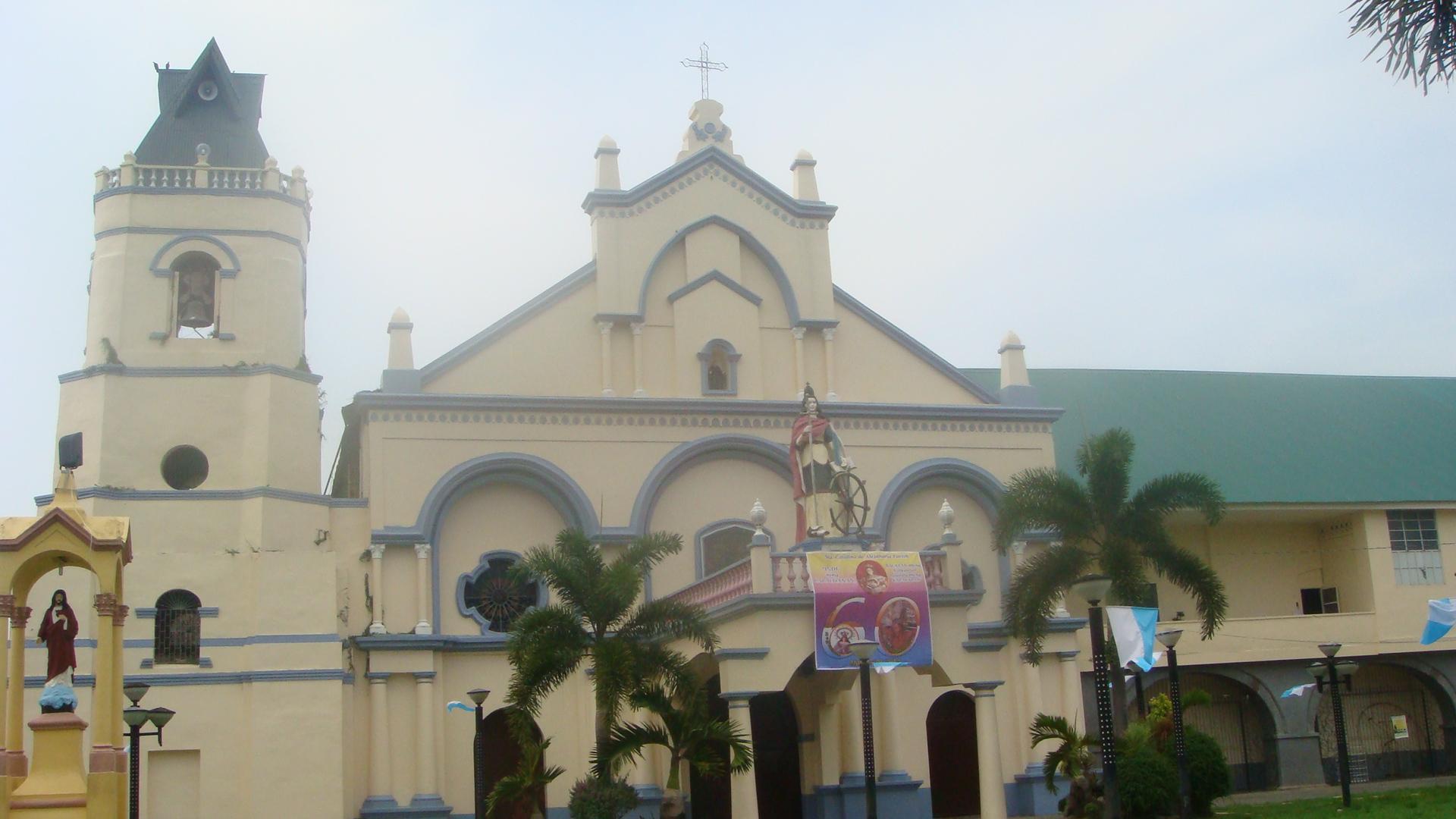
St. Andrew Parish Church – Candaba
Pampanga today is one of the hottest spots when it comes to Visita Iglesia. The gifted province is wealth of historical and cultural churches that are some declared as National Treasure by National Museum. If you are planning to visit some of beautiful churches ever built, then maybe the Province of Pampanga is the best destination for you.

- Betis Catholic Church in Guagua, Pampanga is one of the churches in the country declared by National Museum as a National Treasure. The church was built in the early 1700s and repaired continually throughout the 1800s. The main attraction is the original ceiling mural of the Holy Family done by the famous painter Simon Flores (1839-1904), the artesian well (dug in the 1800s) in the patio - the first well in the country to be so situated, and the rare betis tree nearby, donated by Prof. Randy David, a sociologist and native of the town. The main altar of the church is designed with ornate carvings and saints peering out of their niches like ancient dolls, and the paintings on the ceiling attract comparison with the Sistine Chapel.
Holy Rosary Parish Church – Angeles

- Holy Rosary Parish Church was built by the people of Angeles City, Pampanga by forced labor system known as "polos y servicios" imposed by the Spanish colonial government from 1877 to 1896. Today, it serves as the city's main religious center, being located at the front of the former city hall, now known as the Museo ning Angeles. Local devotees flock the church and faithfully attend activities especially during the Holy Week. Two of the awaited activities are the Good Friday Procession, where bare-footed followers of the Apung Mamacalulu, or the Holy Sepulchre join the procession in the city complex; and the Salubong, held at the Nepo Parking Lot, that ends with the traditional meeting of the Risen Christ and Virgin Mary amidst the fireworks.
Sta. Catalina Church – Arayat

- Sta. Catalina Church was built in honor of St Catherine of Alexandria. Fr. Jose Torres had the present church restored in 1858. This was continued during the term of Fr. Juan Tarrero and completed under the supervision of Fr. Urbano Beduya in 1892. Several renovations have been conducted since then. The church measures 70 meters long and 16 meters wide, 12 meters high and was done in three-level Renaissance style facade.
St. Nicholas of Tolentino Parish Church – Macabebe

- St. Nicholas of Tolentino Parish Church (Macabebe) - It was founded in 1575 under the advocation of San Nicolas de Tolentino. The church measures 70m. long, 17m. wide and 11m. high. The facade of the church has scantly ornamentation and its architectural symmetry is lost amid and the various forms assumed the windows and the main entrance. Simple neo-classic lines of the facade.
St. Monica Parish – Minalin

- St. Monica Parish was constructed by the Augustinians in 1834, reconstructed in 1854. It is situated on the town's highest ground called burul, but despite its elevation, silt from the river has already invaded its beautiful church. The peeled palitada reveals the original red brick walls, giving the church its unique old-rose touches. The ancient mural paintings in the adjoining convent, one of which is a primitive-looking map with details of trees, ducks, crows, a boat, a hunter and a crocodile. It also features the corbels and beams in the convent and high up in the church's ceiling, with carvings that some say depict pre-Hispanic pagan deities like naga (serpent), dapu (crocodile) and galura (eagle), but Siuala ding Meangubie believes they depict only one creature, bulig (mudfish).
Our Lady of the Immaculate Concepcion grotto – Arayat
- Our Lady of the Immaculate Concepcion grotto is a religious sanctuary built on top of a hill by Catholic devotees of Brgy. San Juan Bano in Arayat town.
San Agustin Church – Lubao

- The Parish of Saint Augustine is the oldest church in Pampanga. It was built in 1572 by Architect Fr. Antonio Herrera, the Augustinian mission constructed this church in 1614-1630 out of locally made bricks and sand mixed in egg albumin. The church was occupied in 1898 by the revolutionary forces, used as hospital in 1899 by the American forces, and was destroyed in 1942 by the Japanese shelling. It was then repaired in 1949-1952 under the direction of Fr. Melencio Garcia. It measures 82.45m. long, 21.12m. wide and 10.50m. high. The walls are 2.46m thick. It has one nave originally painted by Italian artists, Dibella and Alberoni. The five story belfry 15.31m. high remains unrestored.
Metropolitan Cathedral of San Fernando

- The Metropolitan Cathedral of San Fernando is the seat of the archdiocese of San Fernando, Pampanga. It was established by the Augustinians in the 18th century. The first church structure was first built by the Augustinian friars in 1755, and dedicated to San Fernando III, King of Castile. Made out of wood and thatch, the structure was 70 meters long, 13 meters wide, and 11 meters high. Its first parish priest was Fray Sebastian Moreno of the order of Saint Augustine. From being a parish church, it became a Cathedral when it was established as the seat of the Diocese of San Fernando, which was created on 11 December 1948 by Pope Pius XII. Its first bishop was Mon. Cesar Ma. Guerrero, D.D., who was installed on 8 September 1949.
San Guillermo Parish Church – Bacolor

- San Guillermo Parish Church is named after San Guillermo, the patron saint of Bacolor, Pampanga, the Philippines, where the church is erected. The church was originally constructed by the Agustinian Friars in 1576. The church boasts of having main retablo, side retablos and pulpit that are heavily gilded with gold leaves. The rich decorations of the church depict the Baroque style of architecture. Only half of the original facade of the church can be seen today due to the eruption of Mount Pinatubo in 1991 which half-buried the church. After the volcanic eruption, the town’s people painstakingly excavated the altar and the retablo and relocated it under the dome in order for the tall wooden retablo to fit. The retablos niches are filled with centuries- old statues which were saved from destruction of the lahar. The citizens of Bacolor take pride in their rich heritage which is why they carefully excavated the ornately carved main and side altars and restored in its immaculate condition. The church is already a world famous tourist destination prior to the lahar tragedies and present has remained being so.
St. Benedict’s Institution de Mexico and Sta. Monica Parish Church – Mexico


- Both the Sta. Monica Parish Church and the St. Benedict’s Institution de Mexico were built by Fr. Jose dela Cruz in 1665. However, prior to this account, another author claimed that the church and the convent were severely damaged by earthquakes in 1645 and 1658. Should this be true, the structures could have been older and were only restored in 1665. The old church reveals characteristics of a typically Mexican-Aztec architecture with its massive and, round columns. In 1922, Rev. Fr. Felipe Roque constructed a beautiful façade of the church which still stands today.
Sta. Lucia Church – Sasmuan

- The Santa Lucia Church in Sasmuan was one of the first Roman Catholic churches built in the Philippines by the Spaniards with the political and financial support of the Principalia.
Ivory Image of St. Peter's Shrine – Apalit
- Also called as "Apung Iru" by the town’s people, is life-size statue located in Apalit, Pampanga which is worshipped the whole year round. The image was transferred to its shrine in Capalangan in 1844.
St. Catherine Alexandra Church – Porac

- St. Catherine Parish Church is one of the oldest churches in Pampanga and known for its classical architectures. No records on builder and date of construction of present church. The church measures 70m. long, 16m. wide and 12m. high. The presbytery, ceiling and the main altar have been recently renovated. The original stone of the facade has been covered with cement and painted white
St. Anne Parish Church – Sta. Ana

- St. Anne Parish Church is 58m long, 14m wide and 13 m high. The recently applied coat of red and white paint has turned this centuries old church into a gaudy 20th century anomaly. The massive hexagonal four-storey bellower has blind and open recesses, keeping with the symmetry of the facade. It ends in a balustrated dome topped by a cross.
St. Andrew Parish Church – Candaba

- The simplicity of line and scarcity of ornamentation are the main traits of the facade of this church, the triangular pediment with its protruding center helps maintain the simplicity of line. A new feature of the facade is the depressed three-centered arches of the windows on the second level. The second level is separated by a cornice decorated with geometric designs.
St. Aloysius Gonzaga Parish – San Luis

- The church is located in a place that used to be called Cabagsac, referring to the proliferation of fruit bats. In fact, today, a fishnet is permanently installed high above the altar precisely to catch thousands of bats that are roosting inside the church. The interior is dark, has an ambience of antiquity and mystery and overpowering odor of bat urine. The main attraction is the three-tower facade, perhaps one of its kinds in the country. Not to be missed is the ancient cemetery located in a hidden corner at the back of the church, with some tombstones dating back to the 1800s and bearing the names of the town's prominent families, including Taruc.
San Pedro Apostol Parish Church – Apalit

- Located at the town plaza, it was built in the year 1629 - 1630 and designed in Baroque architecture. The painting on the ceilings and dome are filled with beautiful paintings and are worth studying. The style of the facade is reminiscent of European neo-classic churches. It was rebuilt by Father Antonio Redondo between the years 1876 - 1880. Its towers were finished in 1896 by the Rev. Toribio Fanjul, who purposely made them low to minimize the effects of earthquakes.
St. Joseph Parish Church – Floridablanca
- St. Joseph Parish Church (Floridablanca) - Pseudo-Gothic elements blend subtly along the classic design of the structure. The flame-like arch of the main entrance and lateral doors provide contrast to the triangular pediment. The structures are simple and the large voids lend drama to an otherwise bare design.
Getting to Pampanga
Motorists and commuters will arrive in Pampanga in just 1-½ hours by car or bus from Manila through the North Luzon Expressway exiting via San Fernando, Angeles or Dau Toll Plaza.
All bus lines linking Manila with Baguio, Pangasinan, and Ilocos pass through the province. Philippine Rabbit serves the provincial capital (San Fernando) from Manila. Victory Liner links Angeles City and Olongapo City. Baliwag Transit and E. Jose Transport operates route services from Olongapo City to Cabanatuan City in Nueva Ecija via San Fernando, Pampanga. Arayat Express also serves the San Fernando-Cabanatuan route. Other buses that pass through the towns of Pampanga include Dagupan Bus Lines, Dangwa Tranco, Five Star Bus Co., Farinas Transit, Franco Federico Lines, Maria De Leon Trans, Partas Trans Co. and Viron Transit.
Also, there are jeepneys and/or mini-buses in each town or city that serve inter-zonal points towards other parts of the province.
- http://www.visitmyphilippines.com/index.php?title=Churches&func=all&pid=4370&tbl=0
- http://en.wikipilipinas.org/index.php?title=Holy_Rosary_Parish_Church
- http://en.wikipilipinas.org/index.php?title=Sta._Catalina_Church_(Arayat%2C_Pampanga)
- http://en.wikipilipinas.org/index.php?title=St._Monica_Parish_(Minalin%2C_Pampanga)
- http://en.wikipilipinas.org/index.php?title=Metropolitan_Cathedral_of_San_Fernando
- http://en.wikipedia.org/wiki/San_Guillermo_Parish_Church
- http://www.mexicopampanga.com/index.php/tourists-guide/landmarks.html
- http://en.wikipedia.org/wiki/Sasmuan,_Pampanga
- http://en.wikipilipinas.org/index.php?title=Ivory_Image_of_St._Peter









